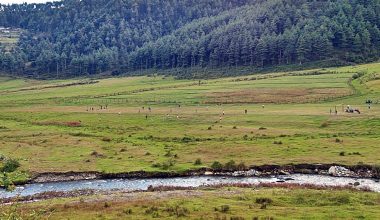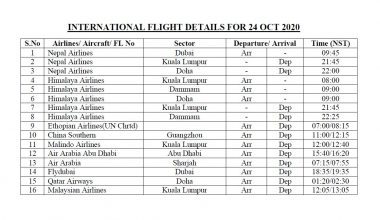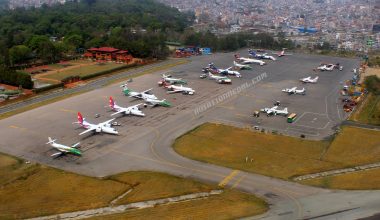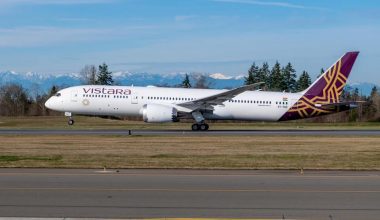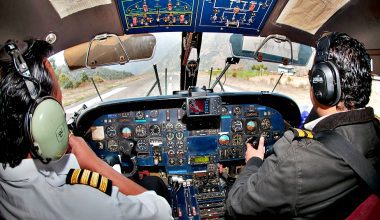Being a pilot involves many responsibilities, generous pay, travel privileges, and societal stature. A pilot study is mandatory to embrace the world’s most rewarding and challenging career. The pilot study doesn’t necessarily imply copious studying, but it involves rigorous and intensive training, which requires significant time and financial commitment. If you aspire to become a pilot in Nepal, here are ten things you must know about the pilot study from Nepal.

1. Qualifications needed to become pilot
If you have decided to build a flying career in Nepal, the first thing to consider is whether you meet the qualifications to become a pilot. Minimum age of 17 years is required to qualify for private pilot license training. On the other hand, you must be at least 18 years to enroll in commercial pilot license training. Regarding educational qualification, a minimum of Nepal Education Board +2 academic degrees (Science faculty with compulsory Physics and Mathematics) will suffice. A bachelor’s degree course isn’t required, but holding it will be a plus point while applying for airline jobs.

2. Medical requirements
The flying profession demands strong physical and mental conditions of the pilots. As a pilot, you must be fit to fly under any condition as it is you to whom expensive aircraft and the lives of passengers are entrusted. You must undergo medical exams undertaken by the Civil Aviation Authority of Nepal (CAAN) approved doctors or clinics. To earn Commercial Pilot License (CPL) and Airline Transport Pilot License (ATPL), you must hold a Class 1 medical certificate which covers heart, chest, hearing, eyes, blood pressure and chemistry, urine, and other necessary tests.
Just as FAA in the US or DGCA in India, CAAN is the civil aviation regulator of Nepal and performs the task of issuing, renewing, and converting pilot licenses.

3. Flight schools for the pilot study
You may meet all medical and educational qualifications for pilot study from Nepal, but unless you enroll in a certified flight school, they are of no avail.
Choosing the right flight school is one of the most important things to know about the pilot study from Nepal. Nepal’s lack of flight schools has obliged aspiring Nepalese pilots to go aboard for pilot courses every year, paying exorbitant prices. However, there are Approved Training Organizations (ATOs) declared and inspected by CAAN. You can enroll in any of the flight institutes that demonstrate compliance with the requirements of the CAAN ATO Procedures Manual. You can learn more about CAAN-approved flight training organizations by visiting the CAAN head office in Babarmahal.
Many students transfer to world-class flight schools in the US, Canada, Australia, South Africa, and the Philippines for pilot study from Nepal. When choosing a foreign country for the pilot study, it is advisable to choose flight schools that offer intensive pilot training at an affordable price, have expert flight instructors, and have pleasant flying weather locations. Also, decide if the specific flying school is approved by CAAN or not.
Holding a foreign license issued by a non-contracting State won’t be recognized by CAAN, meaning such a license can’t be converted into a local license to work in Nepalese airline companies.
4. Cost of the pilot study
Financing a pilot education is an expensive endeavor due to the huge costs involved in aircraft and fueling, airport fees, flight instruction, hangar facility, clearance exams, approvals, etc. You must figure out the cost of the pilot study and do the mental math on how to pay for flight school before joining the flight training. Depending on the flight school and country, becoming a pilot can cost as much as NPR 10.2 million and as little as NPR 4 million.
If money is not the big issue, you can undertake flight training in expensive countries like the US, Canada, and Australia, where the average pilot course costs above $70000. Otherwise, most Nepalese students pursue pilot studies in countries like South Africa and the Philippines, which present an affordable flying course of around $45000 to $55000 USD along with low costs of living.
5. Type of the pilot you aspire to be
While all pilots do the same task of flying the aircraft, there is a difference in the scope, nature, and purpose of the flying licenses they hold. In Nepal, several types of pilot licenses are issued: private pilot licenses, commercial pilot licenses, airline transport pilot licenses, balloon pilot licenses, and glider pilot licenses.

Suppose you want to operate aircraft for non-commercial purposes-to, to fulfill your dream of flying solo, take your families to exotic places by air, enjoy personal flights, etc. In that case, a private pilot license (PPL) is the best option for you. However, if you want to make a living by ferrying passengers and cargo for compensation or hire, you must hold a commercial pilot license (CPL). You will need Airline Transport Pilot License (ATPL) to move your career path into major Nepalese airlines like Nepal Airlines, Himalaya Airlines, etc. A minimum of a frozen ATPL (CPL license + ATPL theory exam cleared) is required to work as a first officer in the airlines of Nepal.
6. License conversion
Another important thing to know about the pilot study from Nepal is the provision of license conversion by the aviation regulatory body. Upon the completion of flight training from a foreign country, the aviation authority of that country (e.g., Federal Aviation Administration FAA in the USA) will evaluate you on a written and flight check basis before issuing the pilot license. Once home in Nepal, you must clear the license conversion written examination and hold a CAAN-issued Nepali pilot license before operating an aircraft registered in Nepal. The civil aviation regulator of Nepal will examine the foreign license/certificate issued by the contracting State regarding its compliance with ICAO Annex 1 prior to the conversion to a Nepalese license.
7. Flying rules and regulations
Even after crossing the final hurdle of earning a Nepalese license, you should know and follow several flying rules and regulations. While holding the license gives you legal permission to fly the aircraft, you must hold an appropriate type rating to exercise the privilege to act as a pilot-in-command or co-pilot of an airplane, helicopter, or a powered lift.
Another rule specified by CAAN is related to license validity. The pilot license granted by the Civil Aviation Authority of Nepal is in compliance with associated requirements, including the validity of the Medical Certificate is valid for a period of 5 years. These licenses cover PPL, CPL, ATPL, Balloon, and Glider Pilot License. Nonetheless, holders of a Microlight/Ultralight Pilot License must renew it every year.
With a Nepalese license, you can soar under the clouds as a pilot of a commercial airliner until you reach your 60th birthday, or in the case of multi-crew aircraft, your 65th birthday. You have a whole youth phase ahead to exercise the privilege of license in commercial air transport operations, but it is restricted after you cross 65 years of age.
8. Salary of a pilot in Nepal
Once you acquire the flying license and appropriate type rating, it’s now time to reap the award of handsome pay, which is more than sufficient. Unlike flat annual pay in several professions, pilots receive hourly pay, which differs based on their seniority and the routes they fly. In Nepal, a senior pilot flying on international routes earns a gross monthly salary of Rs 600,000, while the co-pilot makes around Rs 400,000. The pay is comparatively low in regional/domestic routes as the senior pilot and co-pilot operating the airliner on domestic networks earn up to Rs 400,000 and Rs 190,000, respectively.
Each pilot’s earnings are different from others depending on the airlines, flight experience, aircraft operation, seniority, and so on.
9. Scope of pilots in Nepal
To give a flying start to your pilot profession, you must get a decent job in an air company. The good news is airlines are expanding gradually in terms of fleet capacity and route networks in Nepal. Unlike the number of handful carriers in the past, the air scenario is improving every day with the entry of newcomers into the airline market. With the increase in the sheer amount of daily flights and the number of people taking to the skies, the scope of pilots is bright in Nepal.
10. Flight privileges
Nepal holds special respect and societal stature for professional pilots like in other countries. Amidst the crowd of conventional degree holders like doctors and engineers, pilots are the sophisticated professionals who always remain at the forefront of technology and enjoy their passion at work every day. As a pilot, you have many privileges like travel opportunities, lucrative salary, health and insurance benefits, discounted and free flights for family members, etc.
Turn your dream of taking office in the air into reality by building a career in flying. Knowing these ten things about the pilot study from Nepal will surely help you capitalize on flight training opportunities and prepare you for the future profession.

